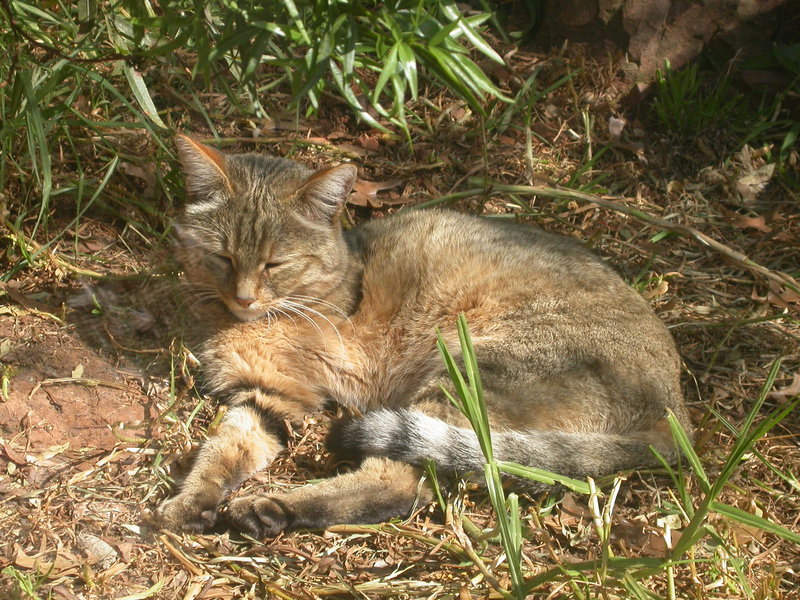| 새로운 사진 | 신문속의 동물소식 | 신기한 동물이야기 | 동물의 소리 | 동물동화상 | 사진 올리기 | 사진 저작권 | English |
|---|
| 재미있는 동물사진 | 괴수/괴어/엽기 동물사진 | 동물이름사전 | 동물목록 | 바깥고리 | 창고입구 | 똑똑누리집 |
|---|
| 이미지 정보 | Original File Name: African Wild Cat-African Wildcat (Felis silvestris lybica.jpg Resolution: 2272x1704 File Size: 1337878 Bytes Date: 2003:05:06 10:05:41 Camera: E4500 (NIKON) F number: f/2.6 Exposure: 10/2142 sec Focal Length: 291/10 Upload Time: 2007:10:24 00:03:27 | |
| 올린이 | 이름 (메일주소): Unknown | |
| 사진 제목 | African Wildcat (Felis silvestris lybica) - Wiki | |
 |
| Email : 카드 | 올린이 | 운영자 사진삭제 정보수정 Admin |
| 설명 | African Wildcat (Felis silvestris lybica) - Wiki
African Wildcat
The African Wildcat (Felis silvestris lybica), also known as the Desert Cat, is a subspecies of the Wildcat (F. silvestris). They appear to have diverged from the other subspecies about 131,000 years ago. Some individual F. s. lybica were first domesticated about 10,000 years ago in the Middle East, and are the ancestors of the domestic cat. Remains of domesticated cats have been included in human burials as far back as 9,500 years ago in Cyprus. Physical characteristics The African Wildcat is sandy brown to yellow gray in color, with black stripes on the tail. The fur is shorter than that of the European subspecies. It is also considerably smaller: the head-body length is 45 to 75 cm (17.7 to 29.5 inches), the tail 20 to 38 cm (7.87 to 15 inches), and the weight ranges from 3 to 6.5 kg (6.61 to 14.3 lbs). Distribution and habitat The African Wildcat is found in Africa and in the Middle East, in a wide range of habitats: steppes, savannas and bushland. The Sand Cat (Felis margarita) is the species found in even more arid areas. Behaviour The African Wildcat eats primarily mice, rats and other small mammals. If the situation permits, it also eats birds, reptiles, amphibians and insects. The cat approaches its prey slowly, and attacks as soon as it reaches a distance of about 1 meter. The African Wildcat is mainly active during the night and twilight. When confronted, the African Wildcat raises its hair to make itself seem like a larger cat and intimidate opponents. At daytime it usually hides in the bushes, although it is sometimes active on dark, cloudy days. The territory of a male overlaps with that of a few females, who defend the territory against intruders. A female gives birth to two to six kittens, with three being average. The African Wildcat often rests and gives birth in cave-like rock piles. The gestation lasts between 56 to 69 days. The kittens are born blind and need the full care of the mother. Most kittens are born in the wet season, when there is sufficient food. They stay with their mother for five to six months, and are fertile after one year. Subspecies origin Based on a mitochondrial DNA study of 979 domestic and wild cats from Europe, Asia, and Africa, Felis silvestris lybica split off from the European wild cat about 173,000 years ago, and from the subspecies F. s. ornata and F. s. cafra about 131,000 years ago. About 10,000 years ago, some Felis silvestris lybica individuals were domesticated in the Middle East. Modern domestic cats are derived from at least five "Mitochondrial Eves". None of the other subspecies of Felis silvestris contributed to the domestic breed, and many of those subspecies own mtDNA is being swamped by interbreeding with feral cats. http://en.wikipedia.org/wiki/African_Wildcat
| |||
| 댓글 |
| |||||||||||||
| 저작권 정보 | 사진의 저작권은 원저작자에게 있습니다. 동물그림창고는 동물관련 사진을 전시할 수 있는 공간만을 제공합니다.사진을 사용하고자 할 경우에는 저작권자와 협의하시기 바랍니다. |
|
|
|
| |||||||
| CopyLeft © since 1995, 동물그림창고. All rights may be reserved. | ||||||||
Stats